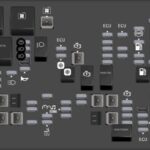Having trouble connecting your OBD2 Bluetooth adapter? Don’t worry, you’re not alone. This guide provides a comprehensive troubleshooting walkthrough to help you pinpoint and resolve common connection problems. We’ll cover everything from selecting the correct device and connection type to addressing potential software glitches and hardware malfunctions. This guide focuses solely on connecting to the OBD2 adapter itself, not on issues communicating with your vehicle’s ECU.
Common OBD2 Bluetooth Adapter Connection Problems and Solutions
Here are some of the most frequent issues encountered when connecting to an OBD2 Bluetooth adapter, along with detailed solutions:
1. Incorrect Device Selection
Often, the problem lies in selecting the wrong device within your OBD2 software settings. You might accidentally choose your car’s multimedia system or another paired Bluetooth device instead of the adapter.
Solution: Navigate to your app’s settings. Look for a section like “Settings -> ELM327 Adapter” or “Connection Settings.” Tap on “Device Name” or a similar option to view a list of available Bluetooth devices. Select your OBD2 adapter. The name is usually “OBDII,” or related to the adapter brand (e.g., Viecar, V-Link, OBDLink). Remember: The adapter name is never your car’s brand or your phone’s brand.
2. Multiple Adapters with the Same Name
Having multiple OBD2 adapters with identical names (often “OBDII”) can cause confusion. The connection relies on the adapter’s unique address, not just its name.
Solution: Access your app’s adapter selection settings as described above. Carefully select the correct adapter. To avoid future confusion, remove any unused or unpaired OBD2 adapters from your phone’s Bluetooth settings.
3. Wrong Connection Type
OBD2 adapters utilize either “classic” Bluetooth or Bluetooth Low Energy (LE/4.0). These are distinct communication protocols.
Solution: Determine your adapter’s Bluetooth type (check the manual or manufacturer’s website). In your app settings, choose the corresponding connection type: “Bluetooth” for classic Bluetooth or “Bluetooth LE (4.0)” for Bluetooth LE. Most Android adapters use classic Bluetooth. iOS generally requires Bluetooth LE.
4. Conflicting Apps
Another app might be using the Bluetooth connection, preventing your OBD2 software from connecting.
Solution: Close any other apps that might be using Bluetooth, especially other OBD2 apps. On iOS, force-quit these apps. On Android, check for background services associated with these apps and terminate them if necessary.
5. Adapter Power Issues
The adapter might be off, asleep, or frozen.
Solution: Unplug and re-plug the adapter into the OBD2 port. If it has a power button, ensure it’s turned on.
6. Bluetooth Stack Issues
Problems with your phone’s Bluetooth software (the “Bluetooth stack”) can hinder connections.
Solution: Toggle your phone’s Bluetooth off and then on. If this doesn’t work, restart your phone.
7. Bluetooth Permissions
Your OBD2 app might lack the necessary permissions to access Bluetooth.
Solution: Grant the app Bluetooth permissions in your phone’s settings. The exact location varies by operating system:
- Android 6.0-11 (and some 12): Settings -> Apps -> [Your OBD2 App] -> Permissions -> Location/Geolocation (Bluetooth permission is often tied to location access).
- Android 12 and above: Settings -> Apps -> [Your OBD2 App] -> Permissions -> Nearby Devices
- iOS: Settings -> Privacy & Security -> Bluetooth -> Enable your OBD2 App.
8. Bluetooth or Adapter Not Enabled
This might seem obvious, but ensure both your phone’s Bluetooth and the adapter itself (if it has a power switch) are turned on.
9. Android Bluetooth Permission Glitch (Android Only)
Sometimes, Android fails to grant a required Bluetooth permission during app installation.
Solution: Reinstall your OBD2 app.
10. Faulty Adapter
If all else fails, the adapter itself might be defective. This is more common than you might think.
Conclusion
By systematically working through these troubleshooting steps, you should be able to diagnose and resolve most OBD2 Bluetooth adapter connection problems. If you continue to experience issues, consult your adapter’s manual or contact the manufacturer for support. A functioning OBD2 adapter is essential for accessing valuable vehicle data, so don’t give up!

